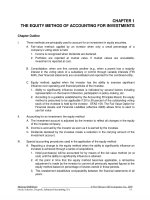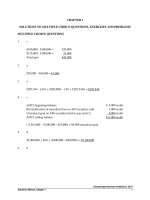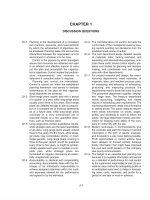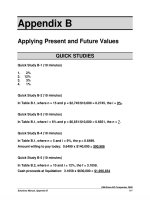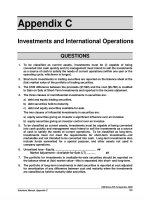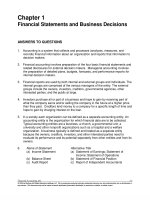Solution manual Financial accounting 6th kieso kimmel ch01
Bạn đang xem bản rút gọn của tài liệu. Xem và tải ngay bản đầy đủ của tài liệu tại đây (822.01 KB, 60 trang )
www.downloadslide.net
Kimmel, Weygandt, Kieso, Trenholm, Irvine
Financial Accounting, Sixth Canadian Edition
CHAPTER 1
The Purpose and Use of Financial Statements
ASSIGNMENT CLASSIFICATION TABLE
Questions
Brief
Exercises
Exercises
1. Identify the uses and
users of accounting.
1, 2, 3, 4
1
1
1A
1B
3, 5, 7
2. Describe the primary
forms of business
organization.
5, 6, 7, 8
2
2
2A
2B
3, 7
3. Explain the three main
types of business
activity.
9, 10, 11,
12
3, 4
3, 4
3A
3B
7
4. Describe the purpose
and content of each of
the financial statements.
13, 14, 15,
16, 17, 18,
19, 20
5, 6, 7, 8,
9, 10
5, 6, 7, 8,
9, 10, 11,
12, 13
4A, 5A,
6A, 7A,
8A, 9A,
10A
4B, 5B,
6B, 7B,
8B, 9B,
10B
1, 2, 4,
6
Study Objectives
A
Problems
B
Problems
BYP
Solutions Manual
1-1
Chapter 1
Copyright © 2014 John Wiley & Sons Canada, Ltd. Unauthorized copying, distribution, or transmission of this page is strictly prohibited.
www.downloadslide.net
Kimmel, Weygandt, Kieso, Trenholm, Irvine
Financial Accounting, Sixth Canadian Edition
ASSIGNMENT CHARACTERISTICS TABLE
Problem
Number
1A
Description
Identify uses of accounting information.
Difficulty
Level
Moderate
Time
Allotted (min.)
30-40
Moderate
20-30
2A
Determine forms of business organization and
accounting standards.
3A
Identify business activities.
Simple
25-30
4A
Classify accounts.
Simple
20-30
5A
Prepare accounting equation.
Simple
20-30
6A
Determine missing amounts; answer questions.
Complex
30-40
7A
Prepare financial statements.
Moderate
35-45
8A
Prepare statement of cash flows; comment on
adequacy of cash.
Moderate
25-35
9A
Calculate missing amounts; explain statement
interrelationships.
Moderate
40-50
10A
Prepare corrected statement of financial position;
identify financial statements for ASPE.
Complex
35-45
1B
Identify users of accounting information.
Moderate
30-40
2B
Determine forms of business organization and
accounting standards.
Moderate
20-30
3B
Identify business activities.
Simple
25-30
4B
Classify accounts.
Simple
20-30
5B
Prepare accounting equation.
Simple
20-30
6B
Determine missing amounts; answer questions.
Complex
30-40
7B
Prepare financial statements.
Moderate
35-45
8B
Prepare statement of cash flows; comment on
adequacy of cash.
Moderate
25-35
Solutions Manual
1-2
Chapter 1
Copyright © 2014 John Wiley & Sons Canada, Ltd. Unauthorized copying, distribution, or transmission of this page is strictly prohibited.
www.downloadslide.net
Kimmel, Weygandt, Kieso, Trenholm, Irvine
Financial Accounting, Sixth Canadian Edition
ASSIGNMENT CHARACTERISTICS TABLE (Continued)
Problem
Number
Description
Difficulty
Level
Time
Allotted (min.)
9B
Calculate missing amounts; explain statement
interrelationships.
Moderate
40-50
10B
Prepare corrected statement of financial position;
identify financial statements for ASPE.
Complex
35-45
Solutions Manual
1-3
Chapter 1
Copyright © 2014 John Wiley & Sons Canada, Ltd. Unauthorized copying, distribution, or transmission of this page is strictly prohibited.
www.downloadslide.net
Kimmel, Weygandt, Kieso, Trenholm, Irvine
Financial Accounting, Sixth Canadian Edition
ANSWERS TO QUESTIONS
1.
Accounting is the information system that identifies and records the economic events
of an organization, and then communicates them to a wide variety of interested users.
2.
Internal users of accounting information work for the company and include finance
directors, marketing managers, human resource personnel, production supervisors,
and company officers.
External users of accounting information do not work for the company. The primary
external users are investors, lenders, and other creditors. Other external users include
labour unions, customers, the Canada Revenue Agency (CRA), and securities
commissions.
3.
Internal users may want the following questions answered:
• Is there enough cash to purchase a new piece of equipment?
• What price should we sell our product for to cover costs and to maximize profits?
• How many employees can we afford to hire this year?
• Which product line is the most profitable?
• How much of a pay raise can the company afford to give me?
External users may want the following questions answered:
• Is the company earning enough to give me my required return on investment?
• Will the company be able to repay its debts as the debts come due?
• Will the company stay in business long enough to service the products I buy from
it?
4.
Ethics are important because, without the expectation of ethical behaviour, the
information presented in the financial statements would have no credibility for the
accounting profession. Without credibility, financial statement information would be
useless to financial statement users.
5.
(a) Proprietorship: Proprietorships are easier to form (and dissolve) than other types of
business organizations. They are not taxed as separate entities; rather, the
proprietor pays personal income tax on the company’s profits. Depending on the
circumstances, this may be an advantage or disadvantage.
Disadvantages of a proprietorship includes unlimited liability (proprietors are
personally liable for all debts of the business) and difficulty in obtaining financing
compared to other forms of organization. In addition, the life of the proprietorship is
limited as it is dependent on the willingness and capability of the proprietor to
continue operations.
Solutions Manual
1-4
Chapter 1
Copyright © 2014 John Wiley & Sons Canada, Ltd. Unauthorized copying, distribution, or transmission of this page is strictly prohibited.
www.downloadslide.net
Kimmel, Weygandt, Kieso, Trenholm, Irvine
Financial Accounting, Sixth Canadian Edition
Answers to Questions (Continued)
5. (Continued)
(b) Partnership: Partnerships are easier to form (and dissolve) than a corporation;
although not as easy as a proprietorship. Similar to a proprietorship, partnerships
are not taxed as separate entities. Instead, the partners pay personal income tax
on their share of profits. Depending on the circumstances this may be an
advantage or disadvantage.
Disadvantages of partnerships include unlimited liability (partners are jointly and
severally liable for all debts of the business) and difficulty in obtaining financing
compared to corporations. In addition, the life of a partnership can be limited
depending on the terms of the partnership agreement and actions of the other
partners.
(c) Private corporation: Advantages of a private corporation include limited liability
(shareholders not being personally liable for corporate debts), indefinite life, and
transferability of ownership. In many cases, depending on the size of the
corporation, a creditor such as a bank will ask for a personal guarantee which will
void the limited liability advantage. In addition, transferability of ownership may be
limited since shares are not publicly traded.
Disadvantages of a private corporation include increased government regulations
and paperwork. The fact that corporations are taxed as a separate legal entity may
be an advantage or a disadvantage and corporations often receive more
favourable income tax treatment than other forms of business organizations. As
mentioned above, depending on the size of the corporation, many of the
advantages of the corporate form are not available to a small private corporation.
(d) Public corporation: The advantages of a public corporation include limited liability,
indefinite life, and transferability of ownership. These features make it easier for
publicly-traded corporations to raise financing compared to other forms of business
organizations. Corporations often receive more favourable income tax treatment
than other forms of business organizations.
Disadvantages include increased government regulations and paperwork. In
addition, because the shares of public companies are listed and traded on
Canadian or other exchanges such as the Toronto Stock Exchange (TSX), these
corporations are required to distribute their financial statements to investors,
lenders, creditors and other interested parties and the general public. This
requirement involves greater costs to the corporation.
Solutions Manual
1-5
Chapter 1
Copyright © 2014 John Wiley & Sons Canada, Ltd. Unauthorized copying, distribution, or transmission of this page is strictly prohibited.
www.downloadslide.net
Kimmel, Weygandt, Kieso, Trenholm, Irvine
Financial Accounting, Sixth Canadian Edition
Answers to Questions (Continued)
6.
While both public and private corporations enjoy many of the same advantages and
disadvantages, one key difference is that public corporations list their shares for sale
to the public on Canadian or other stock exchanges. In contrast, while private
corporations issue shares, they do not make them available to the general public or
trade them on public stock exchanges.
Private corporations may also not enjoy the advantages of limited liability and ease of
transfer of ownership that public corporations generally experience because of their
size and distribution of shares.
7.
(a)
Public corporations must apply International Financial Reporting Standards
(IFRS). Private corporations can apply either IFRS or Accounting Standards for
Private Enterprises (ASPE).
(b)
The information needs of users of public corporations and private corporations
are different. Users of financial information of public corporations require more
extensive disclosure. They may also be benefit from the enhanced comparability
to global companies provided by international standards. Since private
corporations tend to be smaller with easier access to company information, their
users do not require as extensive reporting.
8.
The reporting entity concept means that economic activity of any business
organization or economic entity is kept separate and distinct from the activities of the
owner and all other economic entities. In the case of corporations such as Shoppers
Drug Mart, it also means that economic activities of related corporations that are
owned or controlled by one corporation are consolidated. The results of these
individual companies are also reported separately as separate economic entities.
9.
(a)
(b)
(c)
(d)
(e)
Assets are what the company owns such as cash and equipment.
A liability is an amount the company owes such as accounts payable and income
tax payable.
Shareholders’ equity represents the residual interest (assets less liabilities) of a
company at a point in time and includes share capital and retained earnings, in
addition to other possible components.
Revenues are an increase in a company’s economic resources from operating
activities such as the sale of a product.
Expenses are the cost of assets that are consumed or services that are used in
the process of generating revenues. Examples include cost of goods sold, rent
expense, and salaries expense.
Solutions Manual
1-6
Chapter 1
Copyright © 2014 John Wiley & Sons Canada, Ltd. Unauthorized copying, distribution, or transmission of this page is strictly prohibited.
www.downloadslide.net
Kimmel, Weygandt, Kieso, Trenholm, Irvine
Financial Accounting, Sixth Canadian Edition
Answers to Questions (Continued)
10.
Operating activities are the activities that the organization undertakes to earn a profit.
They include the day-to-day activities which generate revenues and cause expenses
to be incurred. In order to earn profits, a company must first purchase resources they
need to operate. The purchase of these resources (assets) are considered to be
investing activities. Finally, the company must have sufficient funds to purchase assets
and to operate. While some of the necessary cash will be generated from operations,
often the company has to raise external funds by either issuing shares or borrowing
money. Financing activities involve the activities undertaken by the company to raise
cash externally.
11.
(a)
Two examples of operating activities are revenue generated from providing auto
repair services and the expenses related to paying employee salaries.
(b)
Two examples of investing activities are the purchase of property, plant, and
equipment, such as a building, and the sale of a long-term investment.
(c)
Two examples of financing activities for a corporation are borrowing money (debt)
and selling shares (equity).
12.
Local companies providing services and therefore generate service revenue would
include doctors, dentists, law practices and accountants. The names of these
businesses would likely include the name of the practitioners or groups providing these
services.
Local companies providing sales revenue would include farms that provide produce or
milk products and the retail stores selling the local produce to customers.
13.
A fiscal year is an accounting time period that is one year in length, but does not have
to end on December 31. Corporations can select their fiscal year end based on when
their operations are low or when inventory is low. Selecting a fiscal year end when
operations are low provides more time for accounting staff to complete the year-end
reporting requirements. If inventories are low, this simplifies the inventory count and
minimizes the business disruption caused by counting the inventory.
14.
The internal accounting records do use exact figures. However, for presentation
purposes, it is unlikely that the use of rounded figures would change a decision made
by the users of the financial statements. As well, presenting the information in this
manner makes the statements easier to read and analyze thereby increasing their
utility to the users. Rounding the numbers to the nearest million does not have a
material impact on decision-making using the financial statements.
Solutions Manual
1-7
Chapter 1
Copyright © 2014 John Wiley & Sons Canada, Ltd. Unauthorized copying, distribution, or transmission of this page is strictly prohibited.
www.downloadslide.net
Kimmel, Weygandt, Kieso, Trenholm, Irvine
Financial Accounting, Sixth Canadian Edition
Answers to Questions (Continued)
15.
Assets = Liabilities + Shareholders’ Equity
$7,473,721 = $3,150,394 + $4,323,327 (amounts are in thousands of dollars)
16.
A statement of changes in equity explains the changes in the components of
shareholders’ equity, such as share capital and retained earnings. Examples of items
that increase the components are issue of shares (increases share capital) and profit
(increases retained earnings). Examples of items that decrease the components are
repurchases of shares (decreases share capital) and payment of dividends (decrease
retained earnings).
17.
(a)
The primary purpose of the statement of cash flows is to provide financial
information about the cash receipts (inflows) and cash payments (outflows) of a
company for a specific period of time.
(b)
The three categories of the statement of cash flows are operating activities,
investing activities, and financing activities. These categories represent the three
principal types of business activities.
18.
The statement of financial position is prepared as at a specific point in time because it
shows what the business owns (its assets) and what it owes (its liabilities). These
items are constantly changing. It is necessary to select one point in time at which to
present them. The other statements (income statement, statement of changes in
equity, and statement of cash flows) cover a period of time as they report activities and
measure performance that takes place over time.
19.
(a)
The income statement reports profit for the period. The profit figure from the
income statement is shown on the statement of changes in equity as an addition
to beginning retained earnings. If there is a loss it is deducted from the opening
balance of retained earnings.
(b)
The statement of changes in equity explains the change in the balances of the
components of shareholders’ equity (for example, common shares and retained
earnings) from one period to the next. The ending balances are reported in the
shareholders’ equity section of the statement of financial position.
(c)
The statement of cash flows explains the change in the cash balance from one
period to the next. The ending balance of cash reported in the statement of cash
flows agrees with the ending cash balance reported in the current assets section
on the statement of financial position.
Solutions Manual
1-8
Chapter 1
Copyright © 2014 John Wiley & Sons Canada, Ltd. Unauthorized copying, distribution, or transmission of this page is strictly prohibited.
www.downloadslide.net
Kimmel, Weygandt, Kieso, Trenholm, Irvine
Financial Accounting, Sixth Canadian Edition
Answers to Questions (Continued)
20.
(a)
Companies using IFRS must report an income statement, statement of changes
in equity, statement of financial position, and statement of cash flows. In addition,
companies using IFRS may also need to prepare a statement of comprehensive
income.
(b)
Companies using ASPE must report an income statement, statement of retained
earnings, statement of financial position, and a statement of cash flows.
Solutions Manual
1-9
Chapter 1
Copyright © 2014 John Wiley & Sons Canada, Ltd. Unauthorized copying, distribution, or transmission of this page is strictly prohibited.
www.downloadslide.net
Kimmel, Weygandt, Kieso, Trenholm, Irvine
Financial Accounting, Sixth Canadian Edition
SOLUTIONS TO BRIEF EXERCISES
BRIEF EXERCISE 1-1
Investor
Marketing manager
Creditor
Chief financial officer
Canada Revenue Agency
Labour union
(a) Type of Evaluation
(b) Type of User
5
4
3
6
1
2
External
Internal
External
Internal
External
External
BRIEF EXERCISE 1-2
(a)
(b)
(c)
(d)
(e)
1
4
3
2
4
Proprietorship
Private corporation
Public corporation
Partnership
Private corporation
BRIEF EXERCISE 1-3
(a)
(b)
(c)
(d)
(e)
(f)
O
F*
F
F
I
O
Note to instructors: As we will learn later in Chapter 13, companies reporting under IFRS
have a choice in classifying dividends paid as an operating or financing activity. We have
chosen to classify dividends paid as financing activities in this textbook.
Solutions Manual
1-10
Chapter 1
Copyright © 2014 John Wiley & Sons Canada, Ltd. Unauthorized copying, distribution, or transmission of this page is strictly prohibited.
www.downloadslide.net
Kimmel, Weygandt, Kieso, Trenholm, Irvine
Financial Accounting, Sixth Canadian Edition
BRIEF EXERCISE 1-4
1.
2.
3.
4.
5.
6.
(a)
(b)
O
F
O
O
O
I
NE
+
+
-
BRIEF EXERCISE 1-5
(a)
Total assets
=
=
=
Total liabilities + Shareholders’ equity
$55,000 + $120,000
$175,000
(b)
Total assets
=
Total liabilities + Shareholders’ equity (share capital
+ retained earnings)
$170,000 + ($100,000 + $90,000)
$360,000
=
=
(c)
(d)
Total liabilities
Shareholders’ equity
=
=
=
Total assets – Shareholders’ equity (share capital +
retained earnings)
$150,000 – ($50,000 + $25,000)
$75,000
=
=
=
Total assets – Total liabilities
$500,000 – ($500,000 ÷ 2)
$250,000
Solutions Manual
1-11
Chapter 1
Copyright © 2014 John Wiley & Sons Canada, Ltd. Unauthorized copying, distribution, or transmission of this page is strictly prohibited.
www.downloadslide.net
Kimmel, Weygandt, Kieso, Trenholm, Irvine
Financial Accounting, Sixth Canadian Edition
BRIEF EXERCISE 1-6
Beginning of Year: Assets = Liabilities + Shareholders’ equity
Beginning of Year: $800,000 = $500,000 + Shareholders’ equity
Beginning of Year: Shareholders’ equity = $300,000
(a)
($800,000 + $150,000) = ($500,000 – $80,000) + Shareholders’ equity
Shareholders’ equity = $530,000
(b)
Assets = ($500,000 – $50,000) + ($300,000 + $50,000 + $75,000)
Assets = $875,000
(c)
($800,000 – $80,000) = Liabilities + ($300,000 + $110,000)
Liabilities = $310,000
BRIEF EXERCISE 1-7
(a)
(b)
(c)
(d)
(e)
(f)
(g)
(h)
IS
SFP
SCE
SCF
SFP
SCF
IS
SCE
BRIEF EXERCISE 1-8
(a)
(b)
(c)
(d)
(e)
(f)
(g)
(h)
A
L
A
A
SE
L
SE
A
Solutions Manual
1-12
Chapter 1
Copyright © 2014 John Wiley & Sons Canada, Ltd. Unauthorized copying, distribution, or transmission of this page is strictly prohibited.
www.downloadslide.net
Kimmel, Weygandt, Kieso, Trenholm, Irvine
Financial Accounting, Sixth Canadian Edition
BRIEF EXERCISE 1-9
(a)
(b)
(c)
(d)
(e)
(f)
Profit
Issue of common shares
Dividends paid to shareholders
Cash
Loss
Issue of long-term debt
Share
Capital
Retained
Earnings
Total
Shareholders'
Equity
NE
+
NE
NE
NE
NE
+
NE
NE
NE
+
+
NE
NE
BRIEF EXERCISE 1-10
(a)
Beginning balance
Issue additional shares
Profit
Dividends paid
Ending balance
(b)
Beginning balance
Issue additional shares
Loss
Dividends paid
Ending balance
(1)
Common
Shares
$100,000
25,000
$125,000
(1)
Common
Shares
$100,000
25,000
$125,000
(2)
Retained
Earnings
$350,000
75,000
(5,000)
$420,000
(2)
Retained
Earnings
$350,000
(75,000)
(5,000)
$270,000
(3)
Total
Shareholders'
Equity
$450,000
25,000
75,000
(5,000)
$545,000
(3)
Total
Shareholders'
Equity
$450,000
25,000
(75,000)
(5,000)
$395,000
Solutions Manual
1-13
Chapter 1
Copyright © 2014 John Wiley & Sons Canada, Ltd. Unauthorized copying, distribution, or transmission of this page is strictly prohibited.
www.downloadslide.net
Kimmel, Weygandt, Kieso, Trenholm, Irvine
Financial Accounting, Sixth Canadian Edition
SOLUTIONS TO EXERCISES
EXERCISE 1-1
(a)
Chief Financial Officer – Does Facebook generate enough cash to expand its product
line?
Human Resource Manager – What is Facebook’s annual salary expense?
(b)
Creditor – Does Facebook have enough cash available to make its monthly debt
payments?
Investor – How much did Facebook pay in dividends last year?
Other examples are also possible.
EXERCISE 1-2
Public
Private
Proprietorship Partnership Corporation Corporation
1.
2.
3.
No personal liability
Owner(s) pay(s) personal
income tax on company profits
Generally easiest form of
organization to raise capital
F
F
T
T
T
T
F
F
F
F
T
F
4.
Ownership indicated by shares
F
F
T
T
5.
Required to issue quarterly
financial statements
F
F
T
F
6.
Owned by one person
T
F
F
F
7.
Limited life
T
T
F
F
T
F
F
F
F
F
T
F
F
F
F
T
8.
9.
Usually easiest form of
organization to set up
Requires the use of IFRS as
its accounting standards
10. Shares are closely held
Solutions Manual
1-14
Chapter 1
Copyright © 2014 John Wiley & Sons Canada, Ltd. Unauthorized copying, distribution, or transmission of this page is strictly prohibited.
www.downloadslide.net
Kimmel, Weygandt, Kieso, Trenholm, Irvine
Financial Accounting, Sixth Canadian Edition
EXERCISE 1-3
1.
2.
3.
4.
5.
6.
7.
8.
9.
10.
O
I
O
F
F
F
O
O
O
F
EXERCISE 1-4
1.
2.
3.
4.
5.
6.
7.
8.
9.
10.
(a)
(b)
O
I
F
I
O
F
I
F
F
O
+
+
+
+
-
EXERCISE 1-5
1.
2.
3.
4.
5.
6.
7.
8.
SFP
IS, SCE
IS
SCE, SFP
IS
SCE
SFP
IS
9.
10.
11.
12.
13.
14.
15.
SFP
IS
SCF
SCF
SFP
SFP
SCE, SFP
Solutions Manual
1-15
Chapter 1
Copyright © 2014 John Wiley & Sons Canada, Ltd. Unauthorized copying, distribution, or transmission of this page is strictly prohibited.
www.downloadslide.net
Kimmel, Weygandt, Kieso, Trenholm, Irvine
Financial Accounting, Sixth Canadian Edition
EXERCISE 1-6
(a)
Assets – Liabilities = Shareholders’ equity
2014: $440,000 – $290,000 = $150,000
2015: $520,000 – $350,000 = $170,000
(b)
Change in shareholders’ equity $170,000 – $150,000 = $20,000 increase
(c)
1. Profit is $20,000 = the increase in shareholders’ equity
2. Profit is $25,000 = the increase in shareholders’ equity + dividends paid of $5,000
3. Loss of $5,000 = the increase in shareholders’ equity – common shares issued of
$25,000
4. Profit is $15,000 = the increase in shareholders’ equity + dividends paid of $5,000
– common shares issued of $10,000
Solutions Manual
1-16
Chapter 1
Copyright © 2014 John Wiley & Sons Canada, Ltd. Unauthorized copying, distribution, or transmission of this page is strictly prohibited.
www.downloadslide.net
Kimmel, Weygandt, Kieso, Trenholm, Irvine
Financial Accounting, Sixth Canadian Edition
EXERCISE 1-7
[1]
Total revenues – Profit = Total expenses
$1,000,000 – $150,000 = $850,000
[2]
Common shares, end of year $100,000 = Beginning balance of common shares +
Issue of shares of $100,000
[3]
$150,000 equal to profit given above
[4]
Beginning balance of retained earnings plus profit less dividends = Ending balance of
retained earnings.
$0 + $150,000 – Dividends = $100,000
Dividends = $50,000
[5]
Beginning balance in shareholders' equity + Issue of shares + Profit – Dividends =
Ending balance in shareholders’ equity
$0 + $100,000 + $150,000 – $50,000 = $200,000
[6]
Total Assets – Total liabilities = Shareholders’ equity
$1,050,000 – $850,000 = $200,000 or [5] above
[7]
Total revenues – Total expenses = Profit
Total revenues – $250,000 = $50,000
Total revenues = $300,000
[8]
Beginning balance of common shares + Issue of shares = Common shares, end of
year
$0 + Issue of shares = $20,000
Issue of shares = $20,000
[9]
$50,000 equal to profit given above
[10]
Common shares, end of year + Retained Earnings, end of year
$20,000 + $40,000 = $60,000
[11]
Liabilities + Shareholders’ equity = Total assets
$150,000 + $60,000 (from [10]) = $210,000
[12]
$60,000 (from [10]) or $210,000 (from [11]) − $150,000 total liabilities = $60,000 total
shareholders’ equity
Solutions Manual
1-17
Chapter 1
Copyright © 2014 John Wiley & Sons Canada, Ltd. Unauthorized copying, distribution, or transmission of this page is strictly prohibited.
www.downloadslide.net
Kimmel, Weygandt, Kieso, Trenholm, Irvine
Financial Accounting, Sixth Canadian Edition
EXERCISE 1-8
($ in thousands)
(a)
Assets – Liabilities = Shareholders’ equity
2012: $3,243,696 – $2,285,697 = $957,999
2011: $2,940,459 – $2,010,346 = $930,113
(b)
Assets = Liabilities + Shareholders’ equity
2012: $3,243,696 = $2,285,697 + $957,999
Assets = Liabilities + Shareholders’ equity
2011: $2,940,459 = $2,010,346 + $930,113
(c)
Change in shareholders’ equity $957,999 – $930,113 = $27,886 increase
(d)
Shareholders’ equity, Dec. 31, 2011
Add: Profit
Deduct: Dividends
Other shareholders’ equity items
Shareholders’ equity, December 31, 2012
$930,113
?
22,229
65,181
$957,999
Solving for profit: $957,999 + $65,181 + $22,229 − $930,113 = $115,296
Solutions Manual
1-18
Chapter 1
Copyright © 2014 John Wiley & Sons Canada, Ltd. Unauthorized copying, distribution, or transmission of this page is strictly prohibited.
www.downloadslide.net
Kimmel, Weygandt, Kieso, Trenholm, Irvine
Financial Accounting, Sixth Canadian Edition
EXERCISE 1-9
(a)
L
A
L
A
A
SE
A
Accounts payable
Accounts receivable
Bank loan payable
Buildings
Cash
Common shares
Equipment
L
A
A
L
SE
A
Income tax payable
Land
Merchandise inventory
Mortgage payable
Retained earnings
Supplies
(b) Note to instructors: Students may list the accounts in the following statement in any order
within the assets, liabilities, and shareholders’ equity classifications as they have not yet
learned how to classify/order accounts.
AVENTURA INC.
Statement of Financial Position
November 30, 2015
Assets
Cash
Accounts receivable
Merchandise inventory
Supplies
Land
Buildings
Equipment
Total assets
$ 20,000
19,500
18,000
700
44,000
100,000
30,000
$232,200
Liabilities and Shareholders’ Equity
Liabilities
Accounts payable
Income tax payable
Bank loan payable
Mortgage payable
Total liabilities
Shareholders’ equity
Common shares
Retained earnings
Total shareholders’ equity
Total liabilities and shareholders’ equity
$ 26,200
6,000
34,000
97,500
163,700
20,000
48,500
68,500
$232,200
Solutions Manual
1-19
Chapter 1
Copyright © 2014 John Wiley & Sons Canada, Ltd. Unauthorized copying, distribution, or transmission of this page is strictly prohibited.
www.downloadslide.net
Kimmel, Weygandt, Kieso, Trenholm, Irvine
Financial Accounting, Sixth Canadian Edition
EXERCISE 1-10
(a)
E
E
NR
E
R
E
E
R
(b)
Administrative expenses
Cost of goods sold
Dividends
Finance expenses
Finance income
Income tax expense
Selling and distribution expenses
Sales
REITMANS (Canada) Limited
Income Statement
Year Ended February 2, 2013
(in millions)
Revenues
Sales
Finance income
Total revenues
Expenses
Selling and distribution expenses
Cost of goods sold
Administrative expenses
Finance expenses
Total expenses
Profit before income tax
Income tax expense
Profit
$1,000.5
5.6
1,006.1
$550.2
372.1
47.4
1.3
971.0
35.1
8.5
$ 26.6
Solutions Manual
1-20
Chapter 1
Copyright © 2014 John Wiley & Sons Canada, Ltd. Unauthorized copying, distribution, or transmission of this page is strictly prohibited.
www.downloadslide.net
Kimmel, Weygandt, Kieso, Trenholm, Irvine
Financial Accounting, Sixth Canadian Edition
EXERCISE 1-11
KON INC.
Income Statement
Year Ended December 31, 2015
Revenues
Service revenue
Expenses
Salaries expense
Rent expense
Utilities expense
Office expense
Total expenses
Profit before income tax
Income tax expense
Profit
$61,000
$30,000
12,400
2,400
1,600
46,400
14,600
3,000
$11,600
KON INC.
Statement of Changes in Equity
Year Ended December 31, 2015
Balance, January 1
Issued common shares
Profit
Dividends
Balance, December 31
Common
Shares
$20,000
10,000
$30,000
Retained
Earnings
$58,000
11,600
(5,000)
$64,600
Total
Equity
$78,000
10,000
11,600
(5,000)
$94,600
Solutions Manual
1-21
Chapter 1
Copyright © 2014 John Wiley & Sons Canada, Ltd. Unauthorized copying, distribution, or transmission of this page is strictly prohibited.
www.downloadslide.net
Kimmel, Weygandt, Kieso, Trenholm, Irvine
Financial Accounting, Sixth Canadian Edition
EXERCISE 1-12
(a)
Camping revenue
Expenses
Operating expenses
Income tax expense
Profit
(b)
$168,000
$130,000
10,000
140,000
$ 28,000
SEA SURF CAMPGROUND, INC.
Statement of Changes in Equity
Year Ended December 31, 2015
Balance, January 1
Issued common shares
Profit
Dividends
Balance, December 31
Common
Shares
$30,000
10,000
$40,000
Retained
Earnings
$18,000
Total
Equity
$48,000
10,000
28,000
(12,000)
$74,000
28,000
(12,000)
$34,000
Note to instructors: Students may list the accounts in the following statement in any order
within the assets, liabilities, and shareholders’ equity classifications as they have not yet
learned how to classify/order accounts.
SEA SURF CAMPGROUND, INC.
Statement of Financial Position
December 31, 2015
Assets
Cash
Supplies
Equipment
Total assets
Liabilities and Shareholders’ Equity
Liabilities
Accounts payable
Bank loan payable
Total liabilities
Shareholders’ equity
Common shares
Retained earnings
Total shareholders’ equity
Total liabilities and shareholders’ equity
$
7,500
2,500
119,000
$129,000
$
5,000
50,000
55,000
40,000
34,000
74,000
$129,000
Solutions Manual
1-22
Chapter 1
Copyright © 2014 John Wiley & Sons Canada, Ltd. Unauthorized copying, distribution, or transmission of this page is strictly prohibited.
www.downloadslide.net
Kimmel, Weygandt, Kieso, Trenholm, Irvine
Financial Accounting, Sixth Canadian Edition
EXERCISE 1-13
1.
Yu Corporation is distributing nearly all of this year's profit as dividends. This suggests
that Yu is not pursuing rapid growth. Companies that are pursuing opportunities for
growth normally retain their profit and pay low, or no, dividends.
2.
Surya Corporation is not generating sufficient cash from operating activities to fund its
investing activities. The company is borrowing to finance its investing activities. This is
common for companies in their early years of existence. It could also be in an
expansion stage.
3.
Naguib Ltd. is financing its assets in a slightly higher proportion through equity than
through debt. The company has $450,000 ($200,000 + $250,000) of total assets,
which are funded 44.4% ($200,000 ÷ $450,000) by liabilities and 55.6% ($250,000 ÷
$450,000) by equity. Since equity does not have to be repaid and does not require
interest payments, the company appears to be in a healthy financial position.
4.
Rijo Inc. does not have any liabilities and its assets are completely financed by equity.
This places it in a very strong financial position since there are no outside claims on
the company’s assets. This also means that the company is using its own funds to
finance assets. While this reduces risk, it may also reduce return if borrowed funds can
be employed to generate an internal return higher than the cost of borrowing.
Solutions Manual
1-23
Chapter 1
Copyright © 2014 John Wiley & Sons Canada, Ltd. Unauthorized copying, distribution, or transmission of this page is strictly prohibited.
www.downloadslide.net
Kimmel, Weygandt, Kieso, Trenholm, Irvine
Financial Accounting, Sixth Canadian Edition
SOLUTIONS TO PROBLEMS
PROBLEM 1-1A
(a)
1. The South Face Inc. is an external user of accounting information in assessing the
credit-worthiness of their customer.
2. An investor purchasing common shares of Orbite Online, Inc. is an external user.
3. In deciding whether to extend a loan, the Caisse d’Économie Base Montréal is an
external user.
4. As an employee of Tech Toy Limited, the CEO is an internal user.
(b)
1. In deciding to extend credit, South Face would focus its attention on the statement
of financial position of the new customer. The terms of credit they are extending
require repayment in a short period of time. Funds to repay the credit would come
from cash on hand and other current assets. The statement of financial position of
the new customer will show if the company has enough current assets to meet its
current obligations.
2. Since the investor intends to hold the shares for a long period of time (at least five
years), s(he) should focus on the company’s income statement. The income
statement reports the company’s past performance in terms of revenues, expenses,
and profit. This is generally regarded as a good indicator of the company’s future
performance.
3. The Caisse is interested in two things—the ability of the company to make interest
payments on a monthly basis for the next three years and the ability to repay the
principal amount at the end of the three years. In order to evaluate both of these
factors, the focus should be on the statement of cash flows. This statement provides
information on the cash the company generates from its operations on an ongoing
basis. It also tells whether the company is currently borrowing or repaying debt.
4. The CEO should focus on the statement of cash flows as this statement clearly sets
out the cash generated from operating activities and the amount the company has
spent in the past on purchasing equipment and paying dividends.
Note to instructors: Other answers may be valid provided they are properly supported.
Solutions Manual
1-24
Chapter 1
Copyright © 2014 John Wiley & Sons Canada, Ltd. Unauthorized copying, distribution, or transmission of this page is strictly prohibited.
www.downloadslide.net
Kimmel, Weygandt, Kieso, Trenholm, Irvine
Financial Accounting, Sixth Canadian Edition
PROBLEM 1-2A
(a)
(b)
1.
The professors should incorporate their business as a private corporation because
of their concerns about legal liabilities. A corporation is the only form of business
that provides limited liability. Since the professors do not need access to large
amounts of investment capital, a private corporation provides the limited liability
advantage the professors need.
2.
Joseph should run his bicycle rental shop as a proprietorship because this is the
simplest and least costly form of business organization to establish and eventually
dissolve. He is the only person involved in the business and is planning to operate
for a limited time.
3.
Robert and Tom should form a public corporation when they combine their
operations. This is the best form of business for them to choose because they
expect to raise funds in the coming year. A public corporation will enable them to
raise significant amounts of funds for their manufacturing company. A corporation
may also receive more favourable income tax treatment.
4.
A partnership would be the most likely form of business for Darcy, Ellen, and Meg
to choose. It is simpler to form than a corporation and less costly.
5.
Hervé is most likely to select to operate his business as a private corporation. This
will assist him with the liability of storing goods for others. He will also be able to
raise funds to purchase equipment, rent space in airports, and hire employees. It is
easier to raise funds through a private corporation rather than a proprietorship or
partnership.
1.
2.
3.
4.
5.
ASPE
ASPE
IFRS
ASPE
ASPE
Solutions Manual
1-25
Chapter 1
Copyright © 2014 John Wiley & Sons Canada, Ltd. Unauthorized copying, distribution, or transmission of this page is strictly prohibited.

